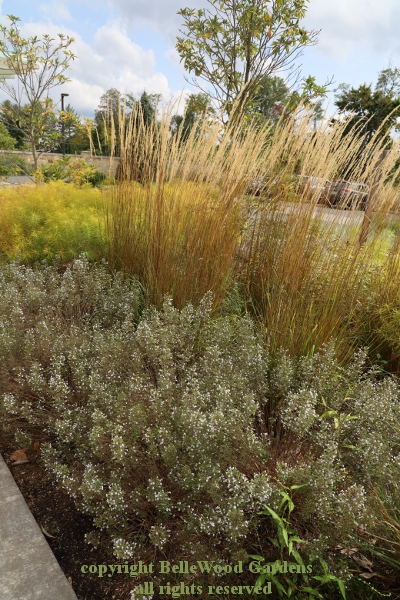
Chlorophyll is disappearing, revealing the yellow it was disguising in leaves.
In fall some plants make a new pigment, anthocyanin, to create rich red hues.
Here, vivid color on a vining woody plant. Look but don't touch! It's poison ivy.
.
If you have any comments, observations, or questions about what you read here, remember you can always Contact Me
All content included on this site such as text, graphics and images is protected by U.S and international copyright law.
The compilation of all content on this site is the exclusive property of the site copyright holder.
Autumn Interest in the Landscape Garden
Monday, 28 September 2020
Summer is a time of lush growth. Flowers everywhere. Long days. Now we are beyond the equinox. Days are winding down as the season changes to autumn. Plants in nature, especially native plants, understand the rhythm of the year.

Chlorophyll is disappearing, revealing the yellow it was disguising in leaves.
In fall some plants make a new pigment, anthocyanin, to create rich red hues.
Here, vivid color on a vining woody plant. Look but don't touch! It's poison ivy.

Grasses bend with a passing breeze, their seed heads orchestrating the dance.
 ericoides.jpg)
This dainty little heath aster makes up with a profusion of its lacy
white flowers any lack in size and color. Symphyotrichum ericoides.

For our gardens we often seek out larger, more colorful flowers. This aster
will soon be so covered with flowers that I doubt much greenery will show.
A prophet, it has been said, is not without honor save in their own country. Familiarity seems to lead to being overlooked. Even with plants. Our roadside wildflowers are ignored at home, rapturously appreciated abroad. Selections and cultivars are developed. Which we then buy at a garden center while passing by their original wild ancestors along the way. If the medium is the message, these planting beds around the parking area of a medical center make excellent use of cultivars of American native plants. Note too that they are used in a formal, gardenesque design and not an intermingled wild landscape. It's the sort of thing Piet Oudolf is noted for creating.

Large sweeps and drifts of grasses and herbaceous perennials.

The fine textured golden foliage is that of Amsonia hubrechtii.

In another area it is paired with the icy blue linear blades of Leymus arenarius,
European blue lyme grass. Beautiful, capable of stabilizing dunes. Also invasive.

Confined between a sturdy stone wall, a concrete curb and asphalt pavement
it is unlikely that blue lyme grass, Leymus arenarius, will manage to escape.

Mountain mint, Pycnanthemum virginianum, has a visitor, a preying mantis.
It is a female. She looks gravid, heavy with eggs. Soon she'll lay an egg case,
called an ootheca. The 30 to 300 eggs will emerge in spring. But she will die
in a couple of weeks afterwards. Preying mantis only live for a few months.

Here's a gathering of a recent foreign invader - spotted lanternfly. They were discovered in Pennsylvania in 2014. They cause serious damage in trees including oozing sap, wilting, leaf curling, and tree dieback. Smash them, put out sticky traps, scrape egg masses into a plastic bag of alcohol and soapy water. They also sometimes feed on butterfly weed, species of Asclepias. The spotted lanternfly die from the cardiac glycosides in Asclepias, the same glycosides that - when ingested by Monarch butterfly larvae feeding on the leaves - make the caterpillars and adult butterflies toxic to birds and other predators.
Honeybees are not native. Neither is red or white clover, oxeye daisies, the sky blue chickory. But not all exotics are good neighbors. Native plants, native insects have an interrelationship that can be disrupted by exotic arrivals. We should appreciate what we have here at home before we seek out something strange merely because it is not native. And then, when we do, look for those that will be good neighbors.
UPDATE: I came back and took a few more pictures in October
Back to Top
Back to September
Back to the main Diary Page